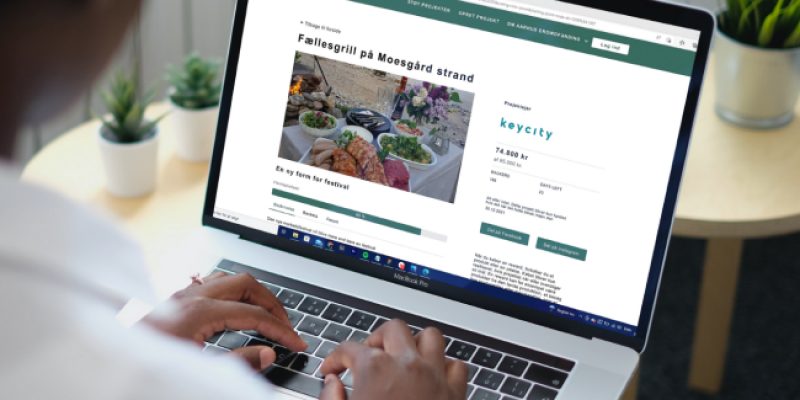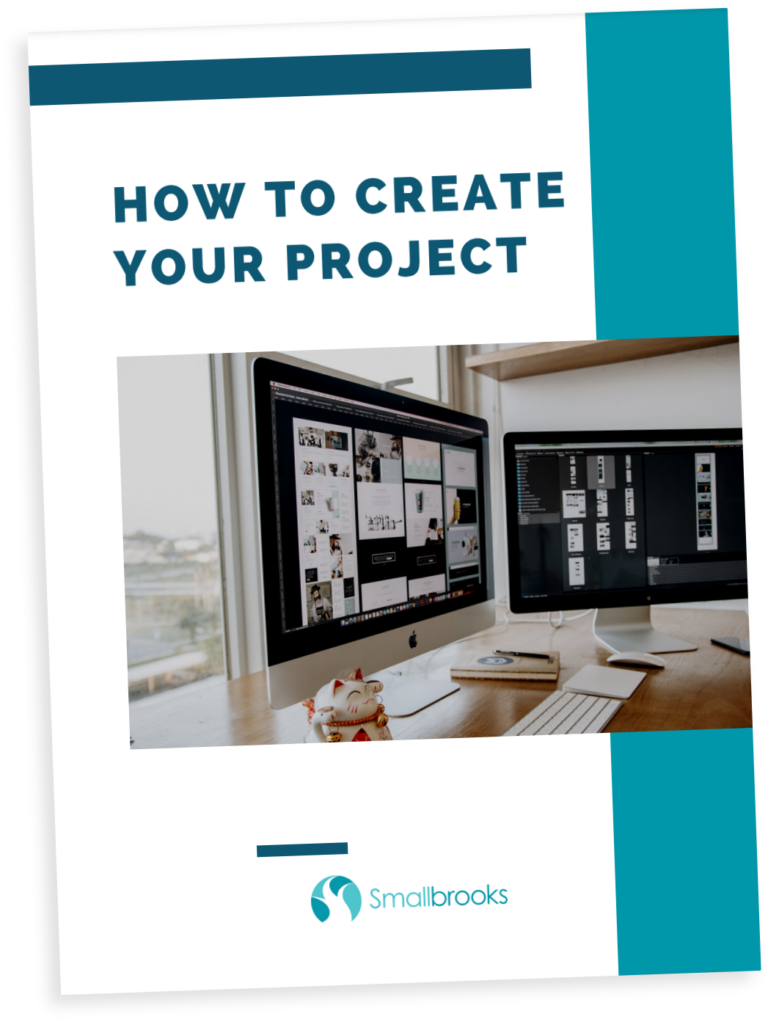Smallbrooks blog
How to create your crowdfunding campaign
By Lennie Olsen
Are you thinking about crowdfunding in Denmark? Then you have some decisions to make and some material to prepare. In this guide, you will be guided through what considerations you must make and deliver to get a project launched.
In essence, we can divide the process of starting a crowdfunding campaign into two: Decisions and Content.
I. Decisions
Before you start working on your crowdfunding campaign, there are some things that you need to consider.
1. Who will be the project owner in the crowdfunding campaign?
It is possible for you to create a crowdfunding campaign as an individual or through an association or company. However, it is easier -and we certainly recommend it- that a company or association is registered as the owner of the project.
Moreover, in addition, in order to launch a project, some formalities must be in order. This means that you and your company/association must be validated. Also, the bank account to which the project is to be paid must be approved by the crowdfunding platform. Additionally, it is important that the bank account belongs to the person, company, or association that is raising the money.

2. Which type of crowdfunding?
At Smallbrooks, we offer a white-label solution where you have the option to select between reward-based, donation-based, or even a combination of both. The choice of which type to opt for largely depends on your identity and the purpose for which you are seeking to raise funds.
Reward-based crowdfunding
The persons that support your project get a reward in return. The reward must have approximately the same value as what the supporter pays. For example, if the reward normally costs DKK 200, you cannot take DKK 500 for it.
If you are a company that sells products, tickets or services, this is probably the right type of crowdfunding for you. It’s really mostly about being creative and thinking about what you can offer in terms of rewards.
In some cases, pricing your rewards can be difficult: What is the value of an autograph? How much does a sponsored link on your website cost? or backstage access to your concert? In these cases, it is a good idea to investigate what price your potential supporters think is fair.
In Denmark, reward crowdfunding is regulated by the purchase law (Købeloven). This means that your backers are entitled to receive their rewards or get their money back.
Donation-based crowdfunding
Refers to those projects where backers give you money without expecting anything in return. Moreover, supporters can typically choose between the different donation amounts suggested in the project, or to donate more. For instance, a donation amount of DKK 50 DKK can be set which means that you have to support the project with a minimum of 50 DKK, but you can also choose to give a bit more, e.g. 65 DKK.
According to the Danish regulation, it is required that you are approved by the Fundraising authority (Indsamlingsnævnet) to receive donations. It is your responsibility as the project owner to apply for this permission. You also have to note that there is an application fee of approx. 1,200 DKK (2022 rates) associated with the process. The average processing time for approval is 14 days.
Combination of de two
Here, a supporter can buy a reward and also has the option to give extra. In the case of this type of project, you might, for example, sell a ticket at the normal price, and then those who want to support more can put a little extra on top. This approach works exceptionally well for projects that have a good cause, as it encourages people to offer increased support.
If you choose this option, you need to have permission from the Fundraising authority (Indsamlingsnævnet) to collect donations. Furthermore, it’s worth noting that your backers are protected by the purchase law (Købeloven).
3. What should be the goal of my crowdfunding campaign?
Determining the right target amount to raise can be challenging. If you set the goal too low, it may not be taken seriously, and you might not secure enough funding to achieve your project’s purpose. Conversely, if you set the goal too high, potential supporters may find it overwhelming: “What good is my 100 DKK if the project needs to raise 500,000 DKK?”
Therefore, you should think carefully about what the money will be used for and who in your network you can draw on.
Moreover, some platforms require that you set both, a minimum and a maximum goal. This means that the project needs at least e.g. 20,000 DKK to reach its goal but can collect a maximum of e.g. 50,000 DKK. If the project only gets 18,000 DKK by the deadline, the money will be paid back to your supporters. Conversely, if the project reaches 50,000 DKK, it will close, even if there is time remaining before the deadline.

4. How long should my crowdfunding campaign last?
We recommend that the crowdfunding campaign runs for 30 to 90 days. However, based on our experience, 45 to 60 days is optimal. This timeframe allows you to effectively promote the project without getting completely exhausted by it.
II. Content of the crowdfunding campaign
The content of a crowdfunding project can be divided into four parts: Text, pictures, video and rewards. All four parts help to sell your project.
1. Text
Your project text should have three parts:
Heading
The title appears on the project card and on social media when someone shares your project. Therefore, it needs to be accompanied by your pitch and your project image to get people to click on the project. In fact, a good headline is worth its weight in gold.
To create an effective headline, it’s essential to keep it short (around 25-30 characters) and focused on your project. Additionally, avoid words like “Help us to”, “Support”, as there’s no place for that in a concise headline. For instance, consider examples such as “New street festival for Tranbjerg”, “Bring the flowers back to the city” and “Give food to the homeless”.
“Pitch”/Short description
In this section, you’ll provide a brief description of your project. You can start with phrases like ‘Help us with,’ ‘Support,’ or ‘Be part of’ to engage your audience. Initiating your pitch with ‘We would like to’ is also an effective way to introduce your project.
Body text
The body text helps the reader understand who you are, what you want to achieve with the project, and why you should be supported. By reading your body text, the reader should desire to support you and the project. Additionally, it should instill a sense of security, assuring them that you have a clear plan for the allocated funds, the capability to bring the project to fruition, and a commitment to fulfilling the promised rewards.
To facilitate a smooth reading experience, consider incorporating descriptive headings throughout the text. These headings act as signposts, guiding the reader through the content and enhancing comprehension.
If you make sure to answer these questions in your text, you are on the right path:
- What is your product /your idea?
- What do you raise money for?
- How does your idea help your local community?
- What do I get as a supporter?
- Who are you/ your team?
2. Images
Images are effective tools to support the message of your project. There are two different types of images in a crowdfunding project: the profile picture and the images in the body text.
Profile picture
This image can be seen on the project card and on social media if your project is shared. It has to make people click on your project, so it is important that it is of good quality. Follow these tips:
- It is a good idea to have only one focus which is centered in the middle.
- Avoid using your logo as a profile picture unless you know it will be recognizable to many visitors. Insert it into your text instead.
- A color image is better than a black-and-white image.
- Make sure the image is in high resolution and preferably taken with a good camera.
Images in the body text
In the text itself, it is highly recommended that you insert images that support what is happening in the text. For example, if you are talking about you and your team, consider inserting a picture of you or your team members. If you have floor plans, prototype designs, or similar visual aids, it’s a good idea to insert them in the relevant sections where you discuss your idea. Here are some great ideas for images you can add:
- Your product.
- Your team/ you.
- Mood shots
- Before/after photos or prototype/design pictures.
- Rewards you offer.
- Your logo.

3. Videos
While it is not a requirement to include a video in your project, it could be a beneficial addition. Furthermore, a video provides an alternative means to introduce yourself or your team and to elaborate on your idea. To make the most of this opportunity, here are some effective strategies to consider:
- Videos should be uploaded on YouTube or Vimeo.
- Keep the length down to 1-2 minutes – so you can also use it on social media, where short videos work best.
- You don’t need to recruit a film crew – just turn your phone horizontally and take a selfie video.
- Make sure the sound is good. If possible, use a microphone and avoid filming in crowded and noisy places.
- Briefly tell us about yourself and your project and how it helps the local community. The rest can be read in your text.
- End with a request: “We need you to”, “Support for”, etc.
4. Rewards/donation tiers
Regardless of the type of crowdfunding campaign you launch, it’s important to create specific “tiers” or “reward levels” that your supporters can purchase. Furthermore, if you choose to offer physical rewards, you should also carefully consider the logistics of delivery.
Set 3-5 rewards/ donation tiers
In general, it is a good idea to set 3-5 rewards or donation tiers so there’s something for all types of backers. For instance, you can consider offering tiers at 50, 250, and 1,000 DKK.
In a donation or combination project, supporters can typically choose to give more. However, our experience shows that many people tend to press the “buy” button. Therefore, it is a good idea to have several levels of rewards/donations to make it extra easy for your backers to contribute larger amounts.
If you offer rewards, it is a good idea to offer rewards at different prices that relate to the project’s purpose. For example, if you want to organize a street festival, it makes sense to sell tickets and beer coupons for the festival. On the other hand, if you’re a voluntary association that needs money to market yourself, merchandise with the association’s logo and slogan is a good idea.
Furthermore, creating a “ladder” of rewards with built-in discounts can be effective. For instance, one ticket costs DKK 250, while two tickets cost DKK 475 (save DKK 25). You can do the same principle to physical products, like offering a glass of jam for DKK 50 or five glasses for DKK 200. This approach appeals to bargain-hunters and enhances the project’s chances of reaching its funding goal.
Delivery
If you have physical rewards, they need to be delivered to your supporters. You can choose to use a shipping company, deliver them yourself, or arrange for your backers to come and collect their rewards themselves.Additionally,
Additionally, if you offer to ship your rewards, remember to factor that into the price. For example, if a t-shirt normally costs DKK 200 without shipping, you must, therefore, set the price of a t-shirt incl. shipping to e.g. DKK 239
On the other hand, if your supporters have to come and collect their reward themselves, your backers will be limited to only those who live in the local area. Nevertheless, it is a really good opportunity to get to meet those who supported you and get them even more involved in your crowdfunding campaign.
Introduction to crowdfunding
New to crowdfunding? Explore our in-depth guide about crowdfunding and crowdfunding platforms. Everything you need to know in one place.
Need an example?
Want to see examples of the platforms we have built? Dive into our customer stories to discover how crowdfunding platforms have benefited other companies.


